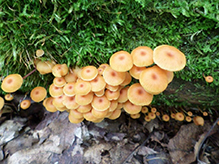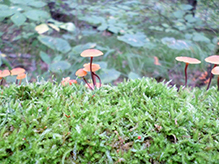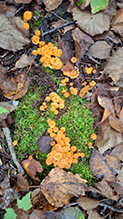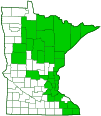Pinewood Gingertail
(Xeromphalina campanella)
Conservation • Description • Habitat • Ecology • Distribution • Taxonomy
Conservation Status |
|||
| IUCN Red List | not listed |
||
| NatureServe | NNR - Unranked |
||
| Minnesota | not listed |
||
Description
Pinewood Gingertail is a common, tiny to small, gilled mushroom. It occurs in Europe, Asia, and North America. It occurs throughout most of the United States and southern Canada, but it is absent from the Great Plains and the Great Basin.
Pinewood Gingertail is found mostly in the summer and fall in Minnesota but nearly year-round in warmer regions. It usually appears in dense clusters, sometimes in groups or alone. It grows on rotting coniferous stumps and logs. It gains its nutrients from decaying wood (saprobic).
The cap is hemispherical, bell-shaped, or convex at first. The mature cap is ⅛″ to 1″ (3.5 to 25 mm) in diameter and broadly convex with a depression in the center. It is yellowish, yellowish brown, brownish yellow, orangish brown, or orange, with a dark center. The surface is hairless and dry. The margins are broadly lined when wet or moist.
The gills are yellowish to orangish. They are fairly well-spaced and they slightly run down the stalk. There are usually many cross veins connecting adjacent gills. Between the primary gills there are short gills that do not extend to the stalk.
The stalk is tough, wiry, often curved, ⅝″ to 1 3⁄16″ (1.5 to 3.0 cm) long, and 1⁄64″ to 1⁄16″ (0.5 to 2.0 mm) thick. It is colored like the cap or yellowish above, grading to orangish brown below. There are bright, orangish-brown hairs near the base.
The flesh is yellowish. It is edible but insubstantial, and the taste is bitter.
The spore print is white.
Similar Species
Cross-veined Troop Mushroom (Xeromphalina kauffmanii) and Pinewood Gingertail are nearly impossible to tell apart by appearance alone. The former grows only on hardwood logs.
Habitat and Hosts
Mixed and coniferous forests. Coniferous logs.
Ecology
Season
Summer and fall
Distribution |
||
|
Sources Biodiversity occurrence data published by: Minnesota Biodiversity Atlas (accessed through the Minnesota Biodiversity Atlas Portal, bellatlas.umn.edu, 10/16/2025). |
|
| 10/16/2025 | ||
Occurrence |
||
Common |
||
Taxonomy
Kingdom
Fungi (Fungi)
Subkingdom
Dikarya
Phylum
Basidiomycota (Basidiomycete Fungi)
Subphylum
Agaricomycotina (Higher Basidiomycetes)
Class
Agaricomycetes (Mushrooms, Bracket Fungi, Puffballs, and Allies)
Subclass
Agaricomycetidae
Order
Agaricales (Common Gilled Mushrooms and Allies)
Suborder
Marasmiineae
Family
Xeromphalinaceae
Genus
Xeromphalina
Section
Xeromphalina
Subordinate Taxa
Synonyms
Agaricus campanella
Agaricus campanella var. myriadea
Agaricus campanella var. papillata
Agaricus caulicinalis ssp. campanella
Agaricus fragilis
Cantharellus valentini
Micromphale fragile
Omphalia campanella
Omphalia campanella ssp. papillata
Omphalia campanella var. myriadea
Omphalia campanella var. papillata
Omphalia campanella var. sparsa
Omphalia campanella var. terrestris
Omphalia fragilis
Omphalina campanella
Omphalina campanella var. terrestris
Omphalopsis campanella
Xeromphalia campanella
Common Names
Bell Omphalina
Golden Trumpet
Orange Fuzzyfoot
Pinewood Gingertail
Glossary
Saprobic
A term often used for saprotrophic fungi. Referring to fungi that obtain their nutrients from decayed organic matter.
Visitor Photos
Share your photo of this fungus.
This button not working for you?
Simply email us at info@MinnesotaSeasons.com.
Attach one or more photos and, if you like, a caption.
Luciearl |
||
 |
 |
|
 |
|
|
MinnesotaSeasons.com Photos
|

Slideshows
Xeromphalina campanella - fungi kingdom
Nineli Lishina
Xeromphalina campanella
Mushrooms Fungi

Visitor Videos
Share your video of this fungus.
This button not working for you?
Simply email us at info@MinnesotaSeasons.com.
Attach a video, a YouTube link, or a cloud storage link.
Other Videos
Xeromphalina campanella (Batsch) Kühner & Maire
NATURATRENTINA
Mushrooms you should know: Bell Omphilina for Golden Trumpet
Nature at Your Door Frank Taylor




